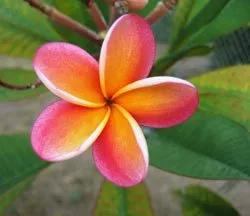Frangipani, also known as Plumeria or Temple Tree, is a beautiful tropical plant that can grow up to 8 meters tall. However, it can only do this with the right care.

The more flowers bloom in the garden, on the terrace, in the conservatory and in the house, the more beautiful the environment in which we move. If it then becomes exotic, these are real highlights and eye-catchers that you cannot avoid. Such a highlight is e.g. the frangipani or also called plumeria. It may be new to you, but once you see this plant you will fall in love with it. It has wonderfully fragrant flowers that shimmer silky. A noble plant that cuts a fine figure on every window sill, balcony and in every pot. But only if it is properly cared for. Because otherwise there won't be any beautiful flowers.
How to properly care for the frangipani
Casting:
In the summer months and on days when the sun shines a lot, it is advisable to water the Plumeria every day. It is best to do this in the morning and evening hours, because then the water does not evaporate as quickly. If the soil is still damp from the previous day, wait until it is completely dry.
Note:
Waterlogging should never occur. Water that collects in the saucer can be harmful to the plant. So always make sure that the irrigation water can drain away unhindered. Here are a few more tips on how to water properly in summer.
Fertilize:
As soon as new leaves have sprout, that happens in spring, you should fertilize the frangipani regularly until July. But avoid over-fertilization. The flower then becomes lazy. From August you should no longer fertilize, because then the rest period for the next flower begins. For frangipani you can use a fertilizer with a high phosphorus content.
Repot:
Frangipani actually grow in the form of trees or shrubs and can grow up to several meters in height. You should only transplant your frangipani when it starts to bleed, as this is a sign that the roots in the flower pot no longer have room. That will be in one and the same after about 4 to 5 yearsflowerpot be the case. It is best to plant the frangipani in spring in a larger flowerpot with fresh substrate.
Cut:
You don't usually need to cut the frangipani. You should only use the scissors if it has become a bit too big. But don't cut them back too radically. Incidentally, branches then form at the resulting interfaces.
Little tip:
You can use the clippings immediately to propagate the frangipani.
Hibernate:
Please don't panic when the flower sheds its leaves in autumn and looks like it has dried up. This is completely normal. It is best to place the plant in a bright spot in the conservatory during the hibernation. However, the temperatures here must not fall below 15 degrees.
During the hibernation, you should only water the plant every three weeks, because it hardly needs any water now. As soon as the plant sprouts again, you can water it a little more and sometimes fertilize it. From the end of May, when no more frost is to be expected, the Plumeria can go outside again. To slowly re-accustom them to the sun, first put them in the shade for a few days and then put them back in the sun.